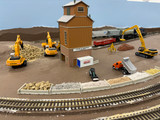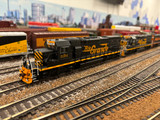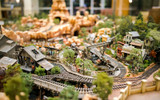Part 5: Setting Up the DCC System
Welcome to Part 5 of our comprehensive guide to Digital Command Control (DCC) for model railroading enthusiasts. In this installment, we will delve into the practical aspects of setting up your DCC system. If you've been following along from the previous parts, you should already have a good understanding of what DCC is and how it works. Now, it's time to bring your DCC system to life by installing the command station, programming decoders, and getting familiar with throttles and accessories.
5.1 Installing the DCC Command Station
The command station is the heart of your DCC system, responsible for sending digital commands to your locomotives and accessories. Here's a step-by-step guide to installing your DCC command station:
5.1.1 Choose the Right Location
Select a suitable location for your command station. It should be in a dry, well-ventilated area and close to a power source. Ensure it's within reach of your layout's track bus.
5.1.2 Connect to Power
Most DCC command stations require a stable power supply. Follow the manufacturer's instructions to connect the command station to the power source, which may involve using a transformer or power supply unit.
5.1.3 Connect to the Track Bus
Attach the command station to the track bus using appropriate wiring, such as twisted pair cables. Ensure that all connections are secure, and there are no loose wires.
5.1.4 Configure Addressing
Set the address for your command station according to the manufacturer's guidelines. This address is essential for communication with your decoders and locomotives.
5.1.5 Test Your Setup
Before moving on, conduct a preliminary test to ensure the command station can communicate with your layout. Check for any issues and address them promptly.
5.2 Programming Decoders and Addresses
Now that your command station is up and running, it's time to program your locomotive decoders with unique addresses and settings. This step is vital to ensure precise control over each locomotive on your layout.
5.2.1 Decoder Installation
If you haven't already, install decoders in your locomotives following the manufacturer's instructions. Each locomotive must have a unique decoder to avoid conflicts.
5.2.2 Decoder Addressing
Using your DCC system's programming features, assign a unique address to each decoder. Addresses typically range from 1 to 127, but refer to your specific system's guidelines for any limitations. This address will be used to control the locomotive.
5.2.3 Programming CVs
CVs (Configuration Variables) control various aspects of decoder behavior, such as acceleration, deceleration, lighting, and sound functions. Use your DCC system's programming track or on-the-main programming to adjust these CVs to your desired settings.
5.2.4 Consistency Checks
Test each locomotive to ensure that it responds correctly to its assigned address and that all functions (lights, sounds, etc.) behave as expected. Make adjustments to CVs as needed.
5.3 Understanding DCC Throttles and Accessories
Now that you have your command station and locomotives set up, it's time to explore DCC throttles and accessories. Throttles are handheld devices or software interfaces that allow you to control your locomotives, while accessories can include turnouts, signals, and other trackside elements.
5.3.1 DCC Throttles
DCC throttles come in various forms, including handheld wireless controllers and computer-based interfaces. Familiarize yourself with your chosen throttle's layout and functions. Most throttles offer speed control, direction control, and access to function buttons for lights and other special features.
5.3.2 Accessory Control
DCC systems often support the control of accessories such as turnouts, signals, and lighting. Program these accessories to respond to specific commands from your throttle, allowing you to control switches and signals effortlessly.
5.3.3 Creating Consists
If you want to control multiple locomotives as a single unit (a consist), learn how to create and manage consists on your DCC system. This is useful for controlling double-heading or multi-unit trains.
Conclusion
Setting up your DCC system involves installing the command station, programming decoders, and getting acquainted with throttles and accessories. With these essential steps completed, you're well on your way to enjoying the full benefits of Digital Command Control in your model railroad hobby. In the next part of our series, we'll explore advanced DCC features and troubleshooting techniques, so stay tuned for more!
Recent Posts
-
All Aboard the Wisdom Express: Life Lessons from Model Railroading
Embarking on the journey of model railroading opens the door to a world where imagination meets prec
-
Capturing History in Miniature: The Art of Prototype Modeling in the Model Railroad World
Prototype modeling in the model railroad world involves creating miniature replicas of real-life tra
-
Unveiling the Imaginative World of Fictional Railroads: Where Creativity Meets the Rails
Model railroading has long been a hobby rooted in historical accuracy and meticulous attention to de




